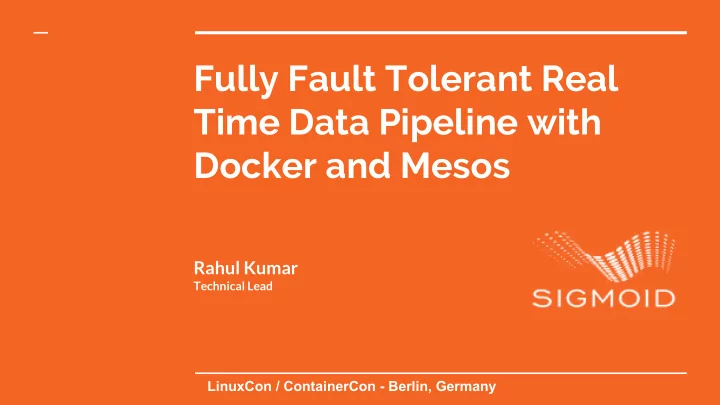

Fully Fault Tolerant Real Time Data Pipeline with Docker and Mesos Rahul Kumar Technical Lead LinuxCon / ContainerCon - Berlin, Germany
● Data Pipeline Agenda Mesos + Docker ● ● Reactive Data Pipeline
Goal Analyzing data always have great benefits and is one of the greatest challenge for an organization.
Today’s business generates massive amount of digital data.
which is cumbersome to store, transport and analyze
Making distributed system and off-loading workload to commodity clusters is one of the better approach to solve data problem
Characteristics Of a distributed system Resource Sharing ❏ Openness ❏ Concurrency ❏ Scalability ❏ Fault Tolerance ❏ Transparency ❏
Collect Store Process Analyze
Data Center
Manually Scale Frameworks & Install services
Complex Very Limited Inefficient Low Utilization
Static Partitioning Blocker for Fault Tolerant data pipeline
Failure make it even more complex to manage
Apache Mesos “Apache Mesos abstracts CPU, memory, storage, and other compute resources away from machines (physical or virtual), enabling fault-tolerant and elastic distributed systems to easily be built and run effectively.”
Mesos Features ● Scalability: scale up to 10,000s of nodes Fault-tolerant: replicated master and slaves using ZooKeeper ● ● Docker support: Support for Docker containers Native Container: Linux Native isolation between tasks with Linux ● Containers Scheduling: Multi-resource scheduling (memory, CPU, disk, and ● ports) API supports : Java, Python and C++ APIs for developing new parallel ● applications Monitoring: Web UI for viewing cluster state ●
Resource Isolation
Docker Containerizer Mesos adds the support for launching tasks that contains Docker images Users can either launch a Docker image as a Task, or as an Executor. To run the mesos-agent to enable the Docker Containerizer, “docker” must be set as one of the containerizers option mesos-agent --containerizers=docker,mesos
Mesos Frameworks ● Aurora: Aurora was developed at Twitter and the migrated to Apache Project later. Aurora is a framework that keeps service running across a shared pool of machines, and responsible for keeping them running forever. Marathon: It is a framework for container orchestration for Mesos. ● Marathon helps to run other framework on Mesos. Marathon also runs other application container such as Jetty, JBoss Server, Play Server. Chronos: Fault tolerance job scheduler for Mesos, It was developed at ● Airbnb as replacement of cron.
Spark Stack R esilient D istributed D atasets (RDDs) - Big collection of data which is: - Immutable - Distributed - Lazily evaluated - Type Inferred - Cacheable
Why Spark Streaming? Many big-data applications need to process large data streams in near-real time Monitoring Systems Alert Systems Computing Systems
What is Spark Streaming? Taken from Apache Spark.
What is Spark Streaming? Framework for large scale stream processing ➔ Created at UC Berkeley ➔ Scales to 100s of nodes ➔ Can achieve second scale latencies ➔ Provides a simple batch-like API for implementing complex algorithm ➔ Can absorb live data streams from Kafka, Flume, ZeroMQ, Kinesis etc.
Spark Streaming Run a streaming computation as a series of very small, deterministic batch jobs - Chop up the live stream into batches of X seconds - Spark treats each batch of data as RDDs and processes them using RDD operations - Finally, the processed results of the RDD operations are returned in batches
Simple Streaming Pipeline Point of Failure
Spark Streaming over a HA Mesos Cluster ● To use Mesos from Spark, you need a Spark binary package available in a place accessible (http/s3/hdfs) by Mesos, and a Spark driver program configured to connect to Mesos. ● Configuring the driver program to connect to Mesos: val sconf = new SparkConf() .setMaster("mesos://zk://10.121.93.241:2181,10.181.2.12:2181,10.107.48.112:2181/mesos") .setAppName("MyStreamingApp") .set("spark.executor.uri","hdfs://Sigmoid/executors/spark-1.3.0-bin-hadoop2.4.tgz") .set("spark.mesos.coarse", "true") .set("spark.cores.max", "30") .set("spark.executor.memory", "10g") val sc = new SparkContext(sconf) val ssc = new StreamingContext(sc, Seconds(1)) ...
Spark Streaming Fault-tolerance Real-time stream processing systems must be operational 24/7, which requires them to recover from all kinds of failures in the system. ● Spark and its RDD abstraction is designed to seamlessly handle failures of any worker nodes in the cluster. ● In Streaming, driver failure can be recovered with checkpointing application state. ● Write Ahead Logs (WAL) & Acknowledgements can ensure 0 data loss.
Simple Fault-tolerant Streaming Infra
Creating a scalable pipeline ● Figure out the bottleneck : CPU, Memory, IO, Network ● If parsing is involved, use the one which gives high performance. ● Proper Data modeling ● Compression, Serialization
Thank You @rahul_kumar_aws LinuxCon / ContainerCon - Berlin, Germany
Recommend
More recommend